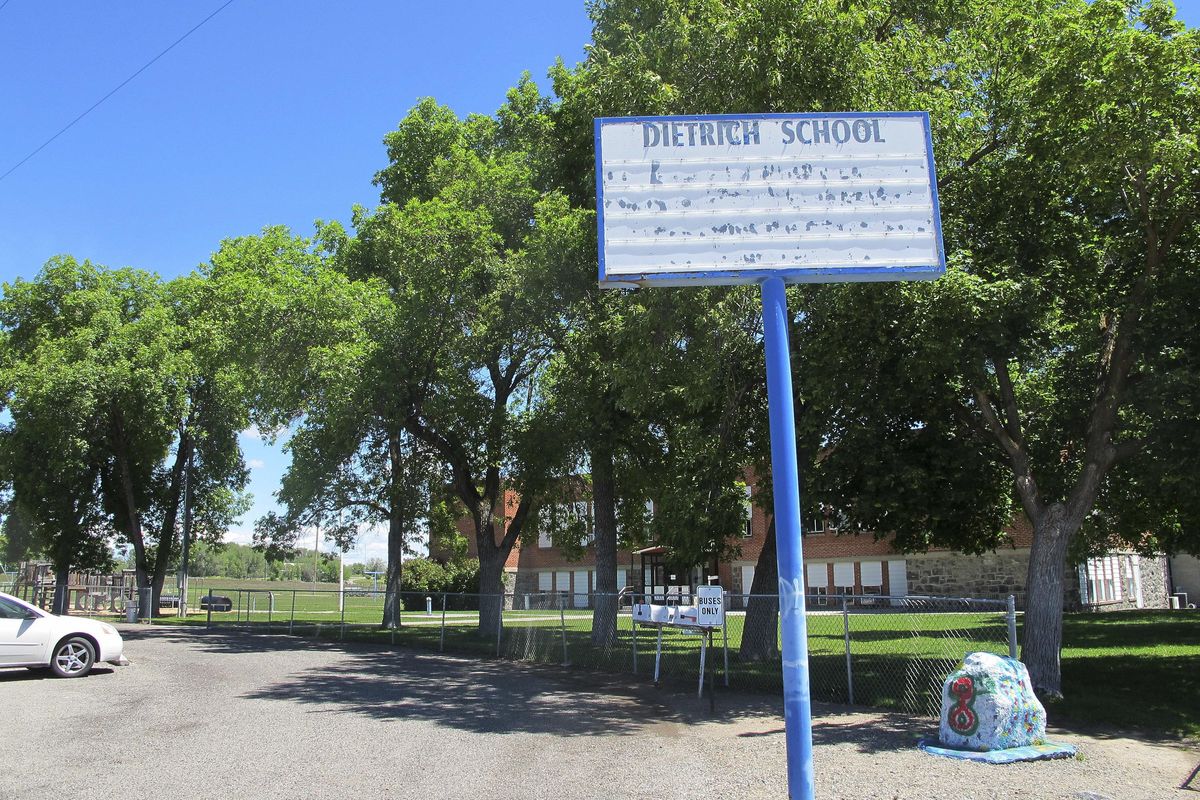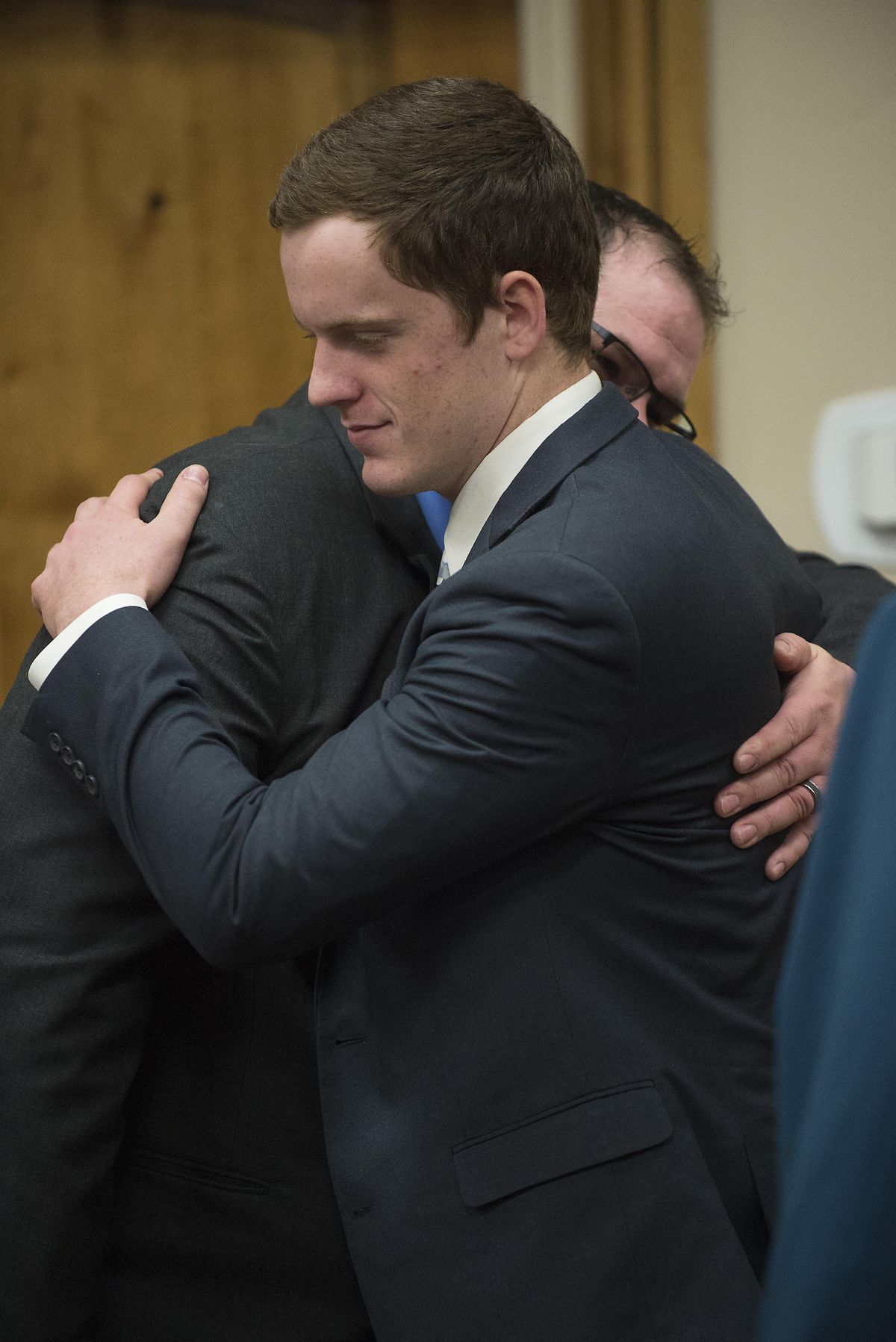Idaho school led locker room assault investigation
In this May 26, 2016, file photo, an empty school reader board stands in front of the only school building in Dietrich, Idaho. (Kimberlee Kruesi / Associated Press)
BOISE – The investigation into the sexual assault of a disabled black football player by his white teammates at a small-town Idaho high school showed that crucial evidence was collected by school employees, not law enforcement officials, and that the culture that led to the attack stretched far beyond the locker room.
John R.K. Howard and two teammates were charged with sodomizing the victim with a clothes hanger in 2015 in the locker room at the high school in the tiny farming village of Dietrich. The sexual assault charge against Howard, who was 18 at the time of the incident, was later dropped. He was sentenced last week to probation for felony injury to a child. The other two cases are sealed because they are being handled in juvenile court.
An Associated Press review of roughly 2,000 pages of documents from the Idaho Attorney General’s office found that school officials did not immediately report the crime. Instead, Superintendent Ben Hardcastle gathered key evidence, including the hanger, and began interviewing the suspects and some of the 27 potential witnesses before notifying the sheriff’s department.
Fellow students, neighbors and even football coaches were allowed to pressure the 17-year-old victim about his testimony, in some cases telling him that the case could bring the town to ruin and send friends to jail.
Like most of his classmates, the victim grew up in Dietrich, though he was one of just a few black children in the community. He also struggled with mental illness and a developmental disability that made it hard for him to describe timelines or immediately recognize the racial implications of the teasing he endured.
The teen ultimately had a breakdown from the stress and had to be institutionalized for a time, according to his mother.
The school locker room was ruled by a so-called “bro code” that forbid students to share what happened there with anyone outside, according to the attorney general’s documents. Coaches were reluctant to be in the room when the boys were changing or showering, an absence that may have allowed the code to thrive.
Racial harassment was common, though some claimed it was unintentional: The victim was nicknamed “grape soda,” “fried chicken” and “Kool-Aid” by his teammate and coaches. The coaches later said they did not know the nicknames were based on racial stereotypes. School officials knew that a student had drawn a cartoon of the victim sitting in the back of a bus on a classroom whiteboard, and the victim later reported that Howard frequently called him a racial slur and showed him a KKK song.
Locker-room bullying escalated in the months before the attack, according to the documents. Some players showed dominance by “dry humping” teammates. Teammates occasionally tried to hit each other in the testicles. Wedgies – a prank in which the fabric of a boy’s underwear is yanked up into his buttocks – were commonplace.
The coaches knew about at least some of the behavior. At least one player, Howard, had previously lost playing time as a penalty for aggressively humping other students.
Before practice on Oct. 22, 2015, one player gave the victim a wedgie that ripped the waistband of his underwear and exposed his buttocks. Then a teammate shoved him into a bathroom and humped him so hard that students outside heard banging.
After practice, things escalated. Witnesses gave conflicting statements, but the documents suggest one suspect asked the victim for a hug and then held the victim while another shoved a coat hanger between the boy’s buttocks. A third player, Howard, kicked the hanger at least once and possibly as many as three times, according to witness reports.
After the victim screamed in pain, a teammate pulled the hanger out and flung it aside before a coach walked into the room. The coach did not ask the victim why his underwear was ripped or what happened, the documents said.
The assault went unreported until the next day, when the victim’s brother told their mother about it. She immediately contacted the superintendent before taking her son to a hospital for an exam.
Hardcastle began interviewing team members and, based on their statements, took two coat hangers from the locker room.
Then, deciding that the Lincoln County Sheriff’s Office would be too busy because a deputy had recently died and believing that the boy’s mother would report the incident, Hardcastle opted to wait. He reported the allegations to police the following Monday, four days after the assault, in a phone message.
Idaho law requires school officials to report suspected crimes against children, including abuse, within 24 hours.
Almost a week after the assault, the sheriff’s office notified the school that a criminal investigation was underway. The same day, the county prosecutor asked Idaho Attorney General Lawrence Wasden to take over the case, noting the many personal relationships between the school and law enforcement in the small community.
Wasden agreed. A week later, he sent an investigator to collect interview records, surveillance videos, the hangers and other evidence from the school. That was on Nov. 10, 2015, nearly three weeks after the assault.
The investigator Wasden assigned to the case, Tony Pittz, noted that state officials had to write a warrant and get a judge to sign it before they could collect student records, the hangers and other evidence from the school, a process that took several days.
Many people pressured the victim not to talk about the assault. Fellow students told him the town “would be destroyed” and they would “lose their farms” if a lawsuit filed by the victim’s family went forward, according to the documents.
Information about those interactions was forwarded to the Lincoln County Sheriff’s Office so they could look into possible witness intimidation, Pittz said.
Even the football coaches attempted to manipulate the victim, according to the documents, approaching him with teammates when his parents were not present and recording the conversation.
On the recordings, the coaches urged the victim to “tell the truth,” and his teammates told him how much he was loved. At one point, the victim acknowledged that he was not absolutely sure which way he was facing when the assault occurred, a statement later used to suggest he lied under oath.
The boy’s doctors were worried that being forced to testify could affect his mental health. The prosecutor said that concern in part prompted him to offer a plea deal to Howard. In exchange for his guilty plea to a different felony, prosecutors dropped the sex-crime charge.
The family’s lawsuit alleges that school officials knew about the racial harassment and bullying but failed to take action. The complaint is pending.
The family’s attorney, Keith Roark, told the judge in Howard’s criminal case that the family was outraged by the plea deal.
The outcome of the case has drawn criticism from across the country from people who think the judge went too easy on Howard, perhaps because he was white and the victim was black.
The judge insisted neither sex nor race was behind the crime and that out-of-towners did not understand the case, referring to news reports.
“People from the East Coast have no idea what this case is about,” Judge Randy Stoker said. But “I’m not going to impose a sentence that is not supported by the law.”

